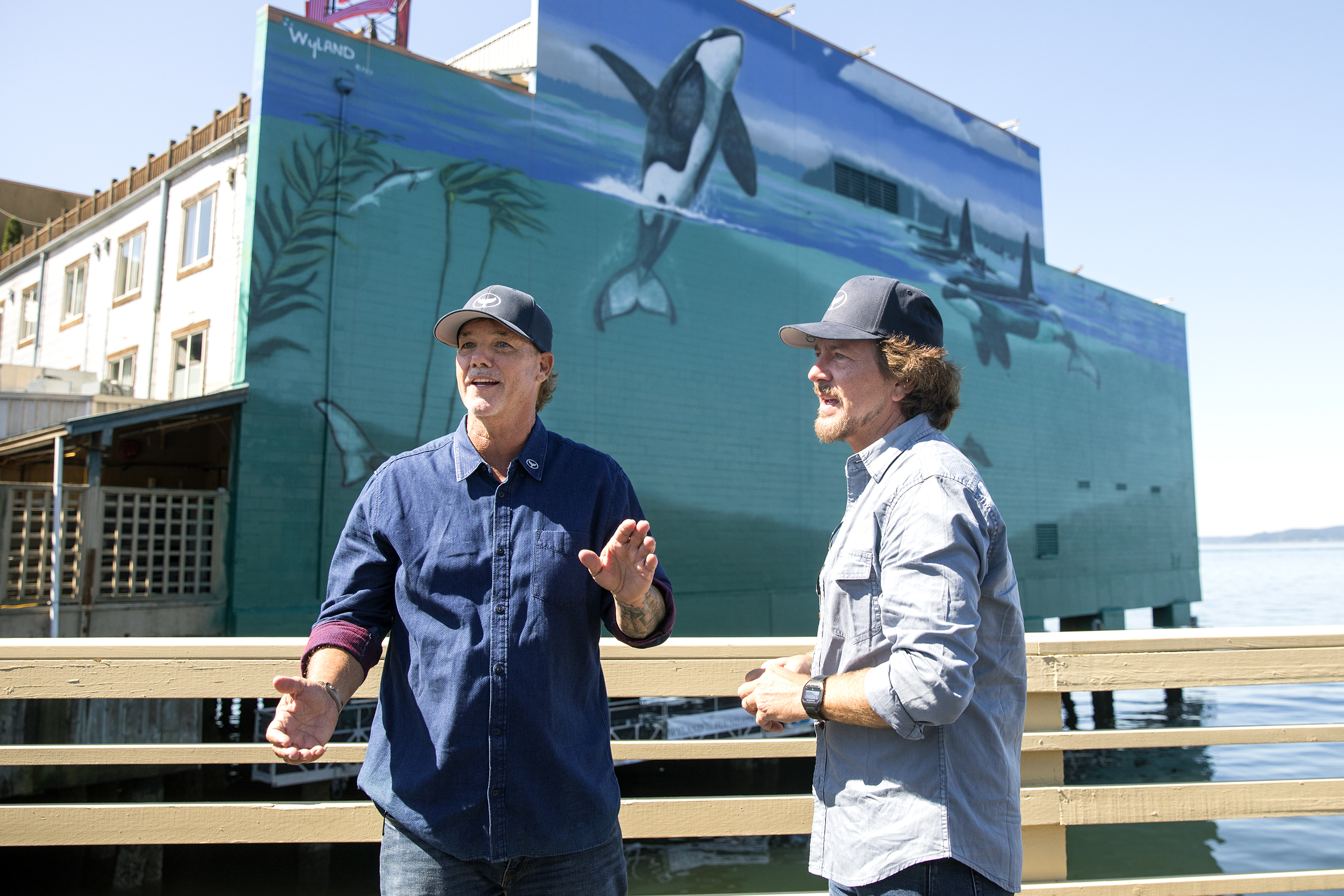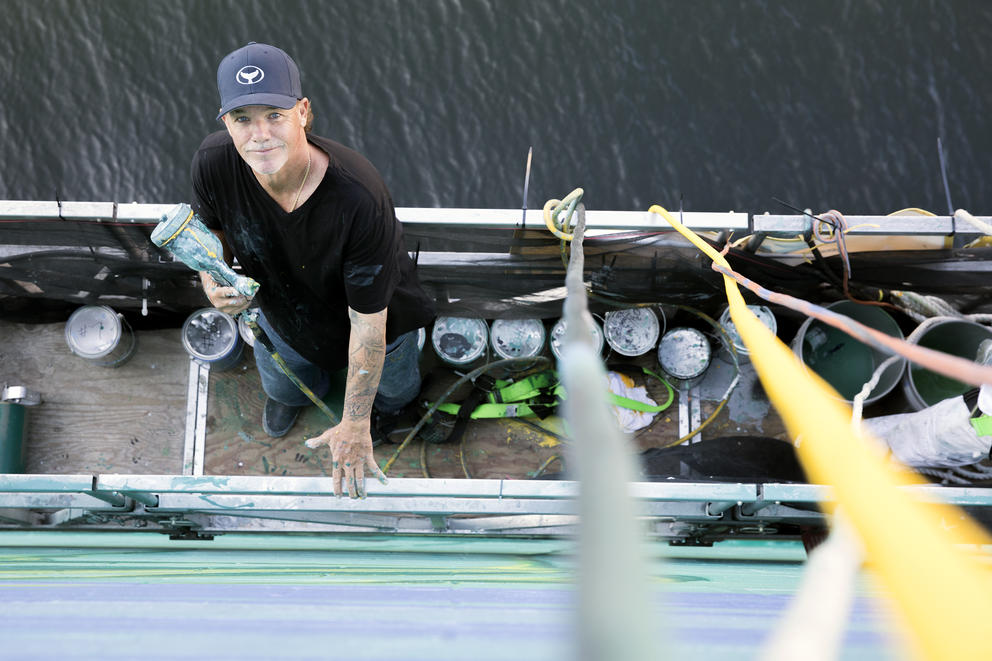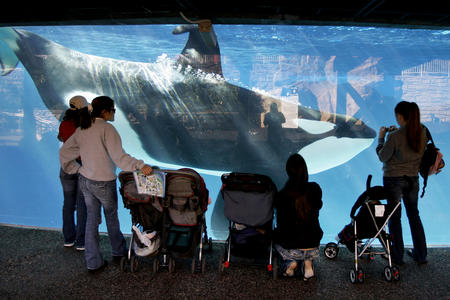Wyland painted whales on this wall once before — 34 years ago, when he created a mural called “The Orcas of Puget Sound” for the Edgewater. His recent Instagram includes a 1985 photo in which he’s standing on the dock in front of the original work, sporting white overalls and a significant mustache. At that point he had barely begun his quest to paint 100 “whaling walls” around the world to raise awareness about marine ecology, clean water and saving the whales. He completed that goal in 2008, when he painted “Hands Across the Oceans” for the Beijing Olympics.
“I was planning on doing 100 whaling walls,” he says, as a stiff breeze blows across the scaffolding. “But this one is so distinctive, I had to do a hundred and one.”
His first Edgewater mural was painted over in 1988. (Accounts vary as to why.) Since then the big blank wall has hovered over the water, seemingly begging for a mural. Here on day three of Wyland’s sprint to paint a giant ode to J-Pod, the endangered band of local orcas, the wall is already a deep sea green, with a dozen or so killer whales swimming, breaching and generally looking majestic.
But everyone’s a critic. “A guy came out on the dock yesterday and said, ‘I’m a naturalist, and those are all males,’ ” Wyland says. He pops open one of the 11 cans of paint lined along the scaffolding basket. “First of all, no they’re not,” he says. “Second of all, when a kid sees this, they’ll care about whales.”
Wyland wears a baseball cap with the image of a whale tail on it, the logo for the Wyland Foundation, also dedicated to his oceanic cause. Eddie Vedder is wearing the same hat, in another Instagram shot from the day before, when the Pearl Jam star stopped by to help Wyland paint a few dorsal fins. “Eddie worked on what we’re calling the V-Pod,” Wyland says. “That’s the family with two kids in the upper right.” Wyland and Vedder know each other from the north shore of Oahu in Hawaii, one of three beachy home bases Wyland migrates between, along with Laguna Beach, California, and Key West, Florida.
“Ready for a mud shark?” Wyland says. The Edgewater has requested he include a mud shark (aka Pacific spiny dogfish), in a nod to several murky legends about the hotel’s rock ’n’ roll guests during the 1960s. The most famous story involves the Beatles fishing out of their hotel room, which in earlier days guests were encouraged to do. While hotel manager Bob Peckenpaugh acknowledges the existence of a sordid tale involving Led Zeppelin and a mud shark, he says the one they’re nodding to purports that Frank Zappa caught a mud shark from his window and kept it in the bathtub of his room.

“I’ve painted thousands of whales, but this is my first mud shark,” Wyland says. He’s not familiar with Zappa’s song “The Mud Shark,” nor is he exactly clear on what the animal looks like. He puts down his spray gun, opens his phone, and pulls up an image. “It’s not that cute,” he says. He wipes his hands on his jeans. “All right, here we go.”
Wyland always paints freehand. “No paint-by-numbers for me,” he says. “Once I put in the background, it’s weird, but I see the whales swimming in it. So I put one in, then I know where the others go.” He uses both the spray gun and a paintbrush for the mud shark, holding his phone in the other hand for reference. “This thing is painting itself,” he says. “Now I’ll give it some movement.”
Asked how painting the whale mural now feels different from when he did it in 1985, Wyland jokes, “Well, I feel older!” (He’s in his 60s.) But then he becomes more solemn. “It feels more serious. Conservation is more important than ever. There’s so much plastic in the ocean now… and it’s coming right up the food chain,” he says, shaking his head. “There’s more urgency this time.” He pauses, as if to get his positive beach vibe back. “But I have a lot of hope when I talk to young people.”
The mud shark has come together in remarkable time. It floats at the waterline among some kelp. It’s probably a little too large in the naturalist’s view, but lovely. “How’s the mud shark look?” Wyland shouts to the small crowd that has assembled to watch from a nearby dock. Thumbs up all around. With that and his signature, which contains “three dots for air, land and sea,” the 101st whaling wall is complete, three decades after its first incarnation.
Wyland says the reward for his work is knowing that people in Seattle appreciate art and the plight of the whales. “I’m dedicating this one to Seattle, to Eddie Vedder and all of Pearl Jam,” he says, just before climbing over the lip of the roof. “But mostly it’s dedicated to the orcas.”







